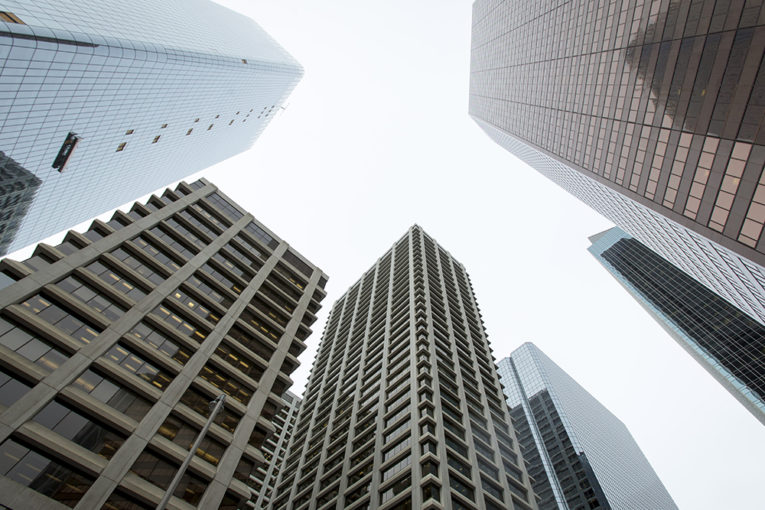
Calgary city council has a hot potato in its hands and needs to come up with a plan that doesn’t leave local businesses getting burned.
But part of the solution could mean tossing higher property taxes on to anxious homeowners across Calgary.
As the city goes through its annual budget planning, council is again confronting a two-year-old concern that isn’t fading away: the shrinking value of downtown office buildings.
“It’s as least as bad as it’s been in the last two years,” Mayor Naheed Nenshi said in an interview Monday.
“The problem is bigger than we had anticipated,” added Coun. Druh Farrell, whose Ward 7 represents part of the downtown core.
The downturn in oil prices in 2015 and ’16 led to thousands of oilpatch layoffs and a dramatic increase in vacant office space in the core.
Under the city’s annual revenue-neutral reassessment process, empty offices and buildings with falling property values pay lower municipal taxes if their assessments decline.
The city, however, still needs a certain amount of money each year to fund services.
The downtown office conundrum has triggered a redistribution of the tax burden on to non-residential property owners outside the core, such as retailers in the suburbs.
Figures haven’t been released on the potential impact for next year, but 2018 data gives a pretty good snapshot of the scale of the problem.
According to city hall information from January, more than 3,800 non-residential property owners were facing a jump in their tax bill of 10 per cent or more due to the shift.
Coming on the heels of a punishing recession, such a hike was untenable.
For the past two years, council has instead dipped into its reserves for $90 million to soften the blow, capping property tax increases on businesses at five per cent.
Even with higher oil prices this year, however, the problem isn’t fixing itself.
The buildings aren’t filling back up.
A study by commercial real estate firm CBRE Ltd. found the office vacancy rate in the city’s downtown dipped slightly to 27.3 per cent during the third quarter.
“You could say it’s getting better because it’s not getting any worse,” said Greg Kwong, CBRE regional managing director. “There’s a bandage on the wound, but it’s still a wound.”
Even with moderate growth, it could take 10 to 12 years to get back to a normal rate of office vacancies in the downtown towers.
This means city council is going to be facing this problem like an annual case of influenza, one that leaves everyone feeling nauseous and looking for a vaccine.
Last year, all of the buildings in the downtown lost $1.6 billion, or more than nine per cent, of their assessed value. In 2016, they shed $3.8 billion.
According to several councillors, the situation is about to get worse if longer-term corrective action isn’t taken.
A look on the potential impact of the trend — which councillors examined earlier this month behind closed doors and which will be released next week — shows another challenging year lies ahead, they say.
“We have a multi, multi, multimillion-dollar gap that we need to try and reconcile,” said Coun. Diane Colley-Urquhart, who represents Ward 13.
“It’s the biggest challenge I’ve had to face as an elected official in 18 years.”
Next week’s meeting of council’s priorities and finance committee to examine the issue “is going to be a come-to-Jesus moment for all of us,” she added.
Part of the solution is to try and get more people living in the downtown core.
Kwong suggests the city should look at repurposing some buildings from office towers to other uses, such as hotels or apartment buildings. Tax incentives to get businesses to relocate downtown could also be considered.
But one solution likely to cause some political heat is the suggestion the city spread the pain across all categories of property owners, including homeowners.
University of Calgary economist Trevor Tombe said in 2014, the tax rate on non-residential property owners was about 3.6 times higher (per dollar of assessed value) than that for residential taxpayers.
By 2018, that number had jumped to 4.1 times, putting more of the burden on businesses.
“They are the ones picking up the slack of fewer dollars coming in from downtown,” Tombe said.
“If we would have held the rate at a similar ratio from 2014 to now, then we are looking at about $118 million, in terms of a lower property tax burden, on business per year.”
The Calgary Chamber of Commerce appreciates the short-term relief council provided to businesses over the past two years, but officials believe a long-term solution is now needed.
“Basically the drop in value has created a $50 million problem,” said the chamber’s Zoe Addington.
“We just think it’s fair when you are looking at a shortfall, it be spread across the board.”
Some councillors like Evan Woolley and Ward Sutherland say the shifting tax picture may necessitate a conversation about sharing some of the burden on to homeowners.
Others like Coun. Jeromy Farkas insist lower spending should be council’s priority.
“Everyone needs relief. It’s tempting, but it’s not so easy robbing Peter to pay Paul,” he said.
“I’m not really today in favour of a wholesale change to that ratio; it would take something to convince me to do that,” noted the mayor.
In the end, there’s no simple solution that will make everyone happy. It will likely take several different strategies to find a cure.
But it’s high time for council to make a decision to tackle a long-term financial problem.
They’ve had more than two years to consider a permanent solution. It’s time to stop passing the hot potato.
Chris Varcoe is a Calgary Herald columnist.
You can read more of the news on source
